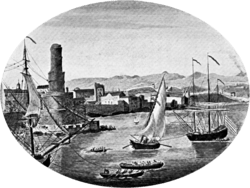Port Royal
| Port Royal | |
|---|---|
| City | |
|
An illustration of pre-1692 Port Royal | |
 Port Royal | |
| Coordinates: 17°56′13″N 76°50′28″W / 17.937°N 76.841°WCoordinates: 17°56′13″N 76°50′28″W / 17.937°N 76.841°W | |
| Country | Jamaica |
| Parish | Kingston |
| Founded | 1518 |
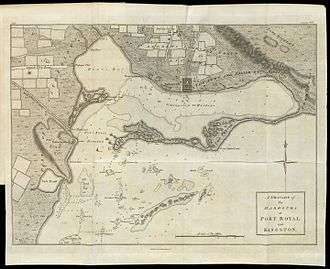
Port Royal is a village located at the end of the Palisadoes at the mouth of the Kingston Harbour, in southeastern Jamaica. Founded in 1518, it was once the largest city in the Caribbean, functioning as the centre of shipping and commerce in the Caribbean Sea by the latter half of the 17th century.[1] It was destroyed by an earthquake in 1692, which had an accompanying tsunami. Severe hurricanes have regularly damaged it. Another severe earthquake occurred in 1907.
Port Royal was once home to privateers encouraged to nip at Habsburg Spain's empire when smaller European powers dared not directly make war on Spain. As a port city, it was notorious for its gaudy displays of wealth and loose morals. It was a popular homeport for the English and Dutch-sponsored privateers to spend their treasure during the 17th century. When those governments abandoned the practice of issuing letters of marque to privateers against the Spanish treasure fleets and possessions in the later 16th century, many of the crews turned pirate. They continued to use the city as their main base during the 17th century. Pirates from around the world congregated at Port Royal, coming from waters as far away as Madagascar.
After the 1692 disaster, Port Royal's commercial role was steadily taken over by the town (and later, city) of nearby Kingston. Plans were developed in 1999 to redevelop the small fishing town as a heritage tourism destination to serve cruise ships. It could capitalize on its unique heritage, with archaeological findings from pre-colonial and privateering years as the basis of possible attractions.[1]
Colonization of Port Royal
Taino
The Taino Indians occupied this area for centuries before European encounter. They used the area, which they called Caguay or Caguaya,[2] during their fishing expeditions. Although it is not known whether they ever settled at the spit, they did inhabit other parts of Jamaica.[3]
Spanish
The Spanish first landed in Jamaica in 1494 under the leadership of Christopher Columbus. Permanent settlement occurred when Juan de Esquivel brought a group of settlers in 1509. They came in search of gold and silver but found none. Instead they began what they saw as a viable alternative: enslaving Taino to cultivate and process the sugar cane which Esquevil had transported from England. Much like the Taino before them, the Spanish did not appear to have much use for the Port Royal area. They did, however, retain its Taino name.[2]
Spain kept control of Jamaica mostly so that it could prevent other countries from gaining access to the island, which was strategically sited within the trade routes of the Caribbean. Spain maintained control over the island for 146 years, until the English took control following their invasion of 1655.
English
The town was captured by England in 1655 during the invasion of Jamaica.[3][4] By 1659 two hundred houses, shops and warehouses had been built around the fort; by 1692 five forts defended the port.[5]
The English initially called the place Cagway but soon renamed it as Port Royal.[2] For much of the period between the English conquest and the 1692 earthquake, Port Royal served as the capital of Jamaica. After the earthquake, Spanish Town was designated as the capital. In 1872 the government designated Kingston, the largest city, as the capital.[5]
Defence of the port
In 1657, as a solution to his defence concerns, Governor Edward D'Oley invited the Brethren of the Coast to come to Port Royal and make it their home port. The Brethren was made up of a group of pirates who were descendants of cattle-hunting boucaniers (later anglicized to buccaneers), who had turned to piracy after being robbed by the Spanish (and subsequently thrown out of Hispaniola).[4] These pirates concentrated their attacks on Spanish shipping, whose interests were considered the major threat to the town.
These pirates later became legal English privateers who were given letters of marque by Jamaica’s governor. Around the same time that pirates were invited to Port Royal, England launched a series of attacks against Spanish shipping vessels and coastal towns. By sending the newly appointed privateers after Spanish ships and settlements, England had successfully set up a system of defence for Port Royal. Spain was forced to continually defend their property, and did not have the means with which to retake its land.[4]
17th century economy
Spain could not retake the island and, due to pirates, could no longer regularly provide their colonies in the New World with manufactured goods. The progressive irregularity of annual Spanish fleets, combined with an increasing demand by colonies for manufactured goods, stimulated the growth of Port Royal. Merchants and privateers worked together in what is now referred to as "forced trade." Merchants would sponsor trading endeavors with the Spanish, while also sponsoring privateers to attack Spanish ships and rob Spanish coastal towns.[4] While the merchants most certainly had the upper hand, the privateers were an integral part of the operation.
Nuala Zahedieh, a lecturer at the University of Edinburgh, wrote, “Both opponents and advocates of so-called ‘forced trade’ declared the town’s fortune had the dubious distinction of being founded entirely on the servicing of the privateers’ needs and highly lucrative trade in prize commodities.”[6] She added, "A report that the 300 men who accompanied Henry Morgan to Portobello in 1668 returned to the town with a prize to spend of at least £60 each (two or three times the usual annual plantation wage) leaves little doubt that they were right.”[6]
The forced trade became almost a way of life in Port Royal. Michael Pawson and David Busseret wrote “...one way or the other nearly all the propertied inhabitants of Port Royal seem to have an interest in privateering.”[7] Forced trade was rapidly making Port Royal one of the wealthiest communities in the English territories of North America, far surpassing any profit made from the production of sugar cane. Zahedieh wrote, “The Portobello raid [in 1668] alone produced plunder worth £75,000, more than seven times the annual value of the island’s sugar exports, which at Port Royal prices did not exceed £10,000 at this time.”[6]
Climate
Port Royal has a tropical savanna climate (Köppen climate classification Aw) with a short dry season from January to April and a lengthy wet season from May to October. Temperatures remain steady throughout the year with the dry season being slightly cooler and range from 25.5 °C (77.9 °F) in January to 27.7 °C (81.9 °F) in May. The average annual precipitation is 1,345 millimetres (53 in).[8]
Piracy in Port Royal

Port Royal provided a safe harbour initially for privateers and subsequently for pirates plying the shipping lanes to and from Spain and Panama. Buccaneers found Port Royal appealing for several reasons. Its proximity to trade routes allowed them easy access to prey, but the most important advantage was the port's proximity to several of the only safe passages or straits giving access to the Spanish Main from the Atlantic.[5] The harbour was large enough to accommodate their ships and provided a place to careen and repair these vessels. It was also ideally situated for launching raids on Spanish settlements. From Port Royal, Christopher Myngs sacked Campeche and Henry Morgan attacked Panama, Portobello, and Maracaibo. Additionally, buccaneers Roche Brasiliano, John Davis and Edward Mansvelt used Port Royal as a base of operations.
Since the English lacked sufficient troops to prevent either the Spanish or French from seizing it, the Jamaican governors eventually turned to the pirates to defend the city.[9] By the 1660s the city had, for some, become a pirate utopia and had gained a reputation as the "Sodom of the New World", where most residents were pirates, cutthroats, or prostitutes. When Charles Leslie wrote his history of Jamaica, he included a description of the pirates of Port Royal:
Wine and women drained their wealth to such a degree that [...] some of them became reduced to beggary. They have been known to spend 2 or 3,000 pieces of eight in one night; and one gave a strumpet 500 to see her naked.[10] They used to buy a pipe of wine, place it in the street, and oblige everyone that passed to drink.
The taverns of Port Royal were known for their excessive consumption of alcohol such that records even exist of the wild animals of the area partaking in the debauchery. During a passing visit, famous Dutch explorer Jan van Riebeeck is said to have described the scenes:
The parrots of Port Royal gather to drink from the large stocks of ale with just as much alacrity as the drunks that frequent the taverns that serve it.
There is even speculation in pirate folklore that the infamous Blackbeard met a howler monkey, while at leisure in a Port Royal alehouse, whom he named Jefferson and formed a strong bond with during the expedition to the island of New Providence. Port Royal benefited from this lively, glamorous infamy and grew to be one of the two largest towns and the most economically important port in the English colonies. At the height of its popularity, the city had one drinking house for every 10 residents. In July 1661 alone, 40 new licenses were granted to taverns. During a 20-year period that ended in 1692, nearly 6,500 people lived in Port Royal. In addition to prostitutes and buccaneers, there were four goldsmiths, 44 tavern keepers, and a variety of artisans and merchants who lived in 2,000 buildings crammed into 51 acres (21 ha) of real estate. 213 ships visited the seaport in 1688. The city’s wealth was so great that coins were preferred for payment over the more common system of bartering goods for services.
Following Henry Morgan’s appointment as lieutenant governor, Port Royal began to change. Pirates were no longer needed to defend the city. The selling of slaves took on greater importance. Upstanding citizens disliked the reputation the city had acquired. In 1687, Jamaica passed anti-piracy laws. Consequently, instead of being a safe haven for pirates, Port Royal became noted as their place of execution. Gallows Point welcomed many to their death, including Charles Vane and Calico Jack, who were hanged in 1720. About five months later, the famous woman pirate Mary Read died in the Jamaican prison in Port Royal. Two years later, 41 pirates met their death in one month.[11]
The Royal Navy in Port Royal
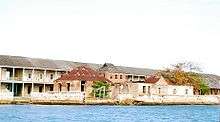
Under British rule the Royal Navy made use of a careening wharf at Port Royal and rented a building on the foreshore to serve as a storehouse. From 1675 a resident Naval Officer was appointed to oversee these facilities;[12] however, development was cut short by the 1692 earthquake. After the earthquake, an attempt was made to establish a naval base at Port Antonio instead, but the climate there proved disagreeable so from 1735 Port Royal once more became the focus of the Admiralty's attention. New wharves and storehouses were built at this time, as well as housing for the officers of the Yard. Over the next thirty years more facilities were added: cooperages, workshops, sawpits, and accommodation (including a canteen) for the crews of ships being careened there.[13] A Royal Naval Hospital was also established on land a little to the west of the Naval Yard; and by the end of the 18th century a small Victualling Yard had been added to the east (prior to this ships had had to go to Kingston and other settlements to take on supplies).[13]
At the start of the 19th century a significant amount of rebuilding took place in what was by now a substantial Royal Navy Dockyard serving the fleet in the Caribbean. A sizeable storehouse with a clocktower formed the centrepiece, with a covered way leading from it to the careening wharves. The adjacent Port Admiral's (later Commodore's) House included a watch tower, to counter the threat of privateers. The Yard continued to expand to meet the new requirements of steam-powered vessels: the victualling wharf became a coaling depot in the 1840s, and twenty years later a small engineering complex was built.[13] The Yard continued to expand through to the beginning of the 20th century, but then (with the Admiralty focusing more and more on the situation in Europe) the Navy withdrew from its station in Jamaica and the Dockyard closed in 1905.
Many of the Dockyard buildings (most of which were of timber construction) were subsequently demolished or destroyed (some in the 1907 Kingston earthquake, others by Hurricane Charlie in 1951).[14] A few remain in place, however, including the Naval Hospital complex, some of the steam engineering buildings and a set of officers' houses.[15] There is also a slipway, completed as late as 1904, which (with its accompanying sheds) was designed for housing and launching torpedo boats, stationed there for the Yard's protection. In 2014 it was announced that some of the Historic Naval Hospital buildings would be restored to house a museum as part of a broader Port Royal Heritage Tourism Project.[16]
Earthquake of 1692 and its aftermath
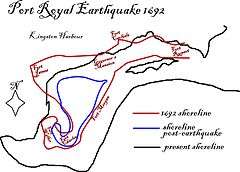
The town grew rapidly, reaching a population of around 6,500 people and approximately 2,000 dwellings, by 1692. As land on which to build diminished, it became common practice to either fill in areas of water and build new infrastructure on top of it, or simply build buildings taller. Additionally, buildings gradually became heavier as the residents adopted the brick style homes of their native England. Some urged the population to adopt the low, wooden building style of the previous Spanish inhabitants, but many refused. In the end, all of these separate factors contributed to the impending disaster.
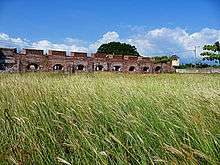
On June 7, 1692, a devastating earthquake hit the city causing most of its northern section to fall into the sea (and with it many of the town’s houses and other buildings). The island lost many of its forts, as well; Fort Charles survived, but Forts James and Carlisle sank into the sea, Fort Rupert became a large region of water, and great damage was done to an area known as Morgan’s Line.[3]
Although the earthquake hit the entire island of Jamaica, the citizens of Port Royal were at a greater risk of death due to the perilous sand, falling buildings, and the tsunami that followed. Though the local authorities tried to remove or sink all of the corpses from the water, they were unsuccessful; some simply got away from them, while others were trapped in places that were inaccessible. Improper housing, a lack of medicine or clean water, and the fact that most of the survivors were homeless led to many people dying of malignant fevers.[17] The earthquake and tsunami killed between 1,000 and 3,000 people combined, nearly half the city's population. Disease ran rampant in the next several months, claiming an estimated 2,000 additional lives.
The historical Jamaica earthquake of June 7, 1692 can be dated closely not only by date, but by time of day as well. This is documented by recovery from the sea floor in the 1960s of a pocket watch stopped, at 11:43 a.m., recording the time of the devastating earthquake.[18][19][20]
The earthquake caused the sand under Port Royal to liquefy and flow out into Kingston Harbour. The water table was generally only two feet down before the impact, and the town was built on a layer of some 65 feet of water-saturated sand. This type of area did not provide a solid foundation on which to build an entire town. Unlike the Spanish before them, the English had decided to settle and develop the small area of land, even while acknowledging that the area was nothing but “hot loose sand”.[21]
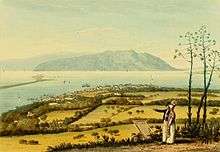
According to Mulcahy, “[Modern] scientists and underwater archaeologists now believe that the earthquake was a powerful one and that much of the damage at Port Royal resulted from a process known as liquefaction.”[21] Liquefaction occurs when earthquakes strike ground that is loose, sandy, and water-saturated, increasing the water pressure and causing the particles to separate from one another and form a sludge resembling quicksand. Eyewitness accounts attested to buildings sliding into the water, but it is likely some simply sank straight down into the now unstable layer.[21]
Underwater archeology, some of which can be seen in the National Geographic Channel show Wicked Pirate City, reveals the foundations of building underwater, showing there was subsidence, as do comparisons of post-earthquake maps and pre-earthquake maps.
Some attempts were made to rebuild the city, starting with the one third that was not submerged, but these met with mixed success and numerous disasters. An initial attempt at rebuilding was again destroyed in 1703 by fire. Subsequent rebuilding was hampered by several hurricanes in the first half of the 18th century, including flooding from the sea in 1722, a further fire in 1750, and a major hurricane in 1774, and soon Kingston eclipsed Port Royal in importance. In 1815, what repairs were being undertaken were destroyed in another major fire, while the whole island was severely affected by an epidemic of cholera in 1850.
Recent history
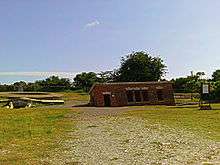
A final devastating earthquake on January 14, 1907, again liquefied the sand spit, destroying nearly all of the rebuilt city, submerging additional portions, and tilting The Giddy House, an artillery storage room built c. 1880 that is today a minor tourist attraction.
Today, the area is a shadow of its former self with a population of less than 2,000 that has little to no commercial or political importance. This is in part a result of abandonment of plans begun in the early 1960s to develop the town as a cruise ship port and destination.[22] The plans stimulated the archaeological explorations on the site which, in turn, led to the suspension of development solely as a port but now included archaeological and other attractions.[5]
In 1981, the Nautical Archaeology Program at Texas A&M University began a 10-year underwater archaeological investigation of the portion of Port Royal that sank underwater during the 17th century. The area the team focused on had sunk directly into the sea and suffered very little damage. Due to very low oxygen levels, a large amount of organic material could be recovered. The efforts made by the program have allowed everyday life in the English colonial port city to be reconstructed in great detail.[23]
In 1998, the Port Royal Development Company commissioned architectural firm The Jerde Partnership to create a master plan for the redevelopment of Port Royal, which was completed in 2000.[24] The focus of the plan is a 17th-century-themed attraction that reflects the city's heritage. It has two anchor areas: Old Port Royal and the King’s Royal Naval Dockyard. Old Port Royal features a cruise ship pier extending from a reconstructed Chocolata Hole harbour and Fisher's Row, a group of cafes and shops on the waterfront. The King’s Royal Naval Dockyard features a combination shipbuilding-museum and underwater aquarium with dioramas for views of the native tropical sealife.[24] The Royal Naval Dockyard also includes the headquarters for the Admiral of the Royal Navy. The redevelopment plan also includes a five-star hotel.[25]
Today, Port Royal is known to post-medieval archaeologists as the "City that Sank".[26] Robert Marx considers it the most important underwater archaeological site in the western hemisphere, yielding 16th–and-17th-century artifacts and many important treasures from indigenous peoples predating its 1588 founding, some from as far away as Guatemala. Several 17th and early 18th century pirate ships sank within Kingston Harbour and are being carefully harvested, under controlled conditions, by various teams of archaeologists. Other "digs" are staked out along various quarters and streets by different teams.
In popular culture
Film
- Port Royal is the "City Beneath the Sea" in the 1953 film of that name.
- Port Royal appears in the film Cutthroat Island directed by Renny Harlin, shot in Thailand and Malta
- Port Royal has been featured as a location within Disney's Pirates of the Caribbean film series, though much of the location work for Port Royal was actually done on the island of Saint Vincent, not in Jamaica.[27]
Literature
- Extensive scenes in Michael Crichton's posthumous novel, Pirate Latitudes (2009), take place in Port Royal in the mid-1660s.
- James Michener's historical novel, The Caribbean (1989), details the history, atmosphere, and geography of Port Royal accurately.
References
- 1 2 Davis, Nick (2012-07-25). "Jamaica's 'wickedest city' Port Royal banks on heritage". BBC News. Retrieved 2016-06-08.
- 1 2 3 Higman, B W; Hudson, B J (2009). Jamaican Place Names (Softcover) (1st ed.). Kingston, Jamaica: University of the West Indies Press. p. 26. ISBN 9789766402174. Retrieved April 9, 2014.
- 1 2 3 Michael Pawson and David Buisseret, Port Royal, Jamaica (London: Oxford University Press, 1975).
- 1 2 3 4 Donny L. Hamilton, "Pirates and Merchants: Port Royal, Jamaica," in X Marks the Spot: The Archaeology of Piracy, ed. Russell K. Skowronek and Charles R. Ewen, 13-30 (Gainesville, Florida: University Press of Florida, 2006).
- 1 2 3 4 Sin City Jamaica. 1998-12-26. History Channel.
- 1 2 3 Nuala Zahedieh, "Trade, Plunder, and Economic Development in Early English Jamaica, 1655-89," The Economic History Review 39, no. 2 (1986): 205-222.
- ↑ Michael Pawson and David Buisseret, Port Royal, Jamaica (Kingston: University of the West Indies Press, 2000).
- ↑ Climate Summary for Port Royal
- ↑ Breverton, Terry (2005). Admiral Sir Henry Morgan: "king of the Buccaneers". Pelican Publishing. ISBN 1455600148.
- ↑ The original source of this story is Alexandre Exquemelin's History of the Bouccaneers of America. The original text adds: "yes, and many other impieties", so "see her naked" is a euphemism for sex.
- ↑ Cindy Vallar. "Notorious Pirate Havens Part 4: Port Royal". Pirates and Privateers - The History of Maritime Piracy. Retrieved September 20, 2008.
- ↑ "Royal Museums Greenwich research guide".
- 1 2 3 Coad, Jonathan (2013). Support for the Fleet: architecture and engineering of the Royal Navy's bases 1700-1914. Swindon: English Heritage.
- ↑ "Jamaica National Heritage Trust".
- ↑ "Jamaica National Heritage Trust".
- ↑ "Jamaica Information Service".
- ↑ Pawson, Michael & Buisseret, David (1975). Port Royal, Jamaica. London: Oxford University Press.
- ↑ "Historic Earthquakes". Earthquake.usgs.gov. Retrieved April 9, 2008.
- ↑ frozen hands on a retrieved watch, the first time in history archaeologists have an (nearly) exact time for an earthquake.
- ↑ History Channel. Ancient Almanac.
- 1 2 3 Mulcahy, Matthew (2008). "The Port Royal Earthquake and the World of Wonders in Seventeenth-Century Jamaica". Early American Studies. 6 (2): 391–422.
- ↑ Cerruti, James (1967). "Jamaica Goes It Alone". National Geographic. 132: 843–873.
- ↑ Donny L. Hamilton, "The Port Royal Project: History of Port Royal," Nautical Archaeology Program, June 1, 2001, . Retrieved March 20, 2009.
- 1 2 Hamilton, Donny L. (April 2006). "Port Royal, Jamaica: Archaeological Past and Development Potential" (PDF). Underwater Cultural Heritage at Risk. International Council on Monuments and Sites: 49–52.
- ↑ "Port Royal Heritage Master Plan". The Jerde Partnership. 2000-01-01. Retrieved September 20, 2008.
- ↑ Nancy Lanthier (March 24, 2007). "Talk tells story of Jamaican 'underwater city'". Vancouver Sun. Retrieved August 20, 2007.
- ↑ Debra Miller, ed. (2005). Caribbean Islands (4 ed.). Footscray, Victoria: Lonely Planet. p. 610. ISBN 978-1-74104-055-5.
External links
| Wikimedia Commons has media related to Port Royal. |
- "360° Virtual Tour". VirtualTravelGlobe.com. Archived from the original on March 13, 2012.
- Brown, Shawn (Cartographer). "Map: Old Port Royal". ShawnBrown.com. (artistic interpretation of the city before the 1692 earthquake )
- Hamilton, Dr. Donny L. (Principal Investigator). "The Port Royal Project". Nautarch.tamu.edu. (historical and archaeological research)
- "Notorious Pirate Havens, Part 4: Port Royal". Great Lakes Pirate Fest. Vermilion Ohio News.
- Vallar, Cindy (Editor and Reviewer). "Piracy in Port Royal". Pirates and Privateers: The History of Maritime Piracy.
- Yosomono, Eric (June 2, 2011). "The 5 Most Extravagant Ways Cities Have Been Wiped Out". Cracked.com.
- Yosomono, Eric Yosomono & Miller, Drew (October 21, 2011). "Absurd Pirate Myths Everyone Believes (Thanks to Movies)". Cracked.com. p. 2.
